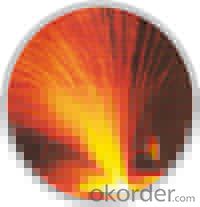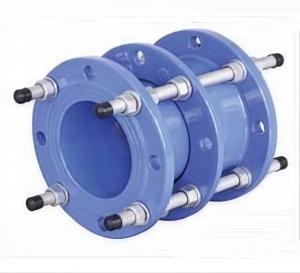By increasing refractory lifetimes steel fiber refractory reinforcement offers the end user a reduction in downtime and substantial savings in materials and labor costs. Melt Extract stainless fibers are fully annealed and therefore are more pliable and ductile. This is of particular benefit during the mixing cycle and when the refractory composite is installed. These pliable fibers are not only more user-friendly than the stiff "needle-like" cut fibers, but also have better flow characteristics. Dispersion is further aided by the optimum Aspect Ratio design guaranteeing rapid fiber separation during the mixing phase.
We provide various types:
The normal diameter of stainless steel fiber is 0.3mm~0.7mm with a length of 20~60mm. To avoid agglomeration during stirring, the ratio of the length to the diameter shoud be controlled in the range of 30~80. It should be noted that if a process of jet spray is applied, stainless steel fiber of a shorter length <25mm should be selected, otherwise the spray jet shall be blocked. For special applications other lengths and diameters are also available.
Cost savings are the main reason for adding stainless steel fibers. In all areas of high thermal and mechanical shock, fibers will at least double refractory life. Fiber costs up to 50% lower than comparable products. Our low cost but high performance melt extract steel fibers provide the quickest payback. Our quality product costs substantially less because we produce our molten steel and spun fiber on-line in one fully integrated manufacturing plant. We are able to keep fiber manufacturing costs to a minimum, which is reflected in the very competitive prices.
We has developed melt extract steel fiber which features thermal shock resistance, steep thermal gradients resistance and mechanical shock resistance, minimizing damage and decaying failure caused by cracking. By increasing refractory lifetimes steel fiber refractory reinforcement offers the end user a reduction in downtime and substantial savings in materials and labor costs.
Production:
Melt Extract stainless steel fibers are spun directly from the melt using the company's advanced Melt Extraction (ME) and Melt Overflow (MO) processes. Rapid cooling of the fiber during manufacture (equivalent to 50,000 per second) "freezes" the metallurgical structure, capturing it in an optimum state to resist high temperature corrosion - a state which is impossible for conventionally cast steel to match.
The processing maximizes the effective distribution of the primary nickel and/or chromium alloying elements throughout the fiber while simultaneously minimizing grain size. When coupled with our skill of blending non-standard levels of performance-enhancing key trace elements to the melt, a unique range of dedicated refractory fiber alloys have been produced which provide outstanding oxidation resistance and unmatched performance at elevated temperature. |  |
Steel Fiber Size:
The normal diameter of stainless steel fiber is 0.3mm~0.7mm with a length of 20~60mm. To avoid agglomeration during sirring, the ratio of the length to the diameter shoud be controlled in the range of 30~80. It should be noted that if a process of jet spray is applied, stainless steel fiber of a shorter length <25mm should be selected, otherwise the spray jet shall be blocked. For special applications other lengths and diameters are also available.
Chemical composition, specifications, packing.
| Type | Chemical Composition(%) | Specifications | Packing |
|---|
| C | Si | Mn | Ni | Cr |
| 304 | ≤0.15 | ≤1.5 | ≤1.5 | 8-12 | 17-20 | 0.3×1×25&0.3×1×35 | 20Kg(CTN、Bag) |
| 310 | ≤0.2 | ≤1.5 | ≤1.5 | 19-22 | 24-27 |
| 330 | ≤0.2 | ≤1.5 | ≤1.5 | 33-37 | 14-17 |
| 446 | ≤0.2 | ≤1.5 | ≤1.5 | ≤0.7 | 24-27 |
| 430 | ≤0.2 | ≤1.5 | ≤1.5 | ≤0.7 | 17-19 |
Steel Fiber Grade:
The grades of steel fiber should be suitably selected based on the temperature and atmosphere.
Physical, Mechanical and corrosion resistant properties of stainless steel fiber

| 304 | 310 | 330 | 446 | 430 |
Melting Point Range ℃ | 1400-1425 | 1400-1450 | 1400-1425 | 1425-1510 | 1425-1510 |
Elastic modulus at 870℃
104MPa | 12.66 | 12.66 | 13.71 | 9.84 | 8.44 |
Tensile strength at 870℃
MPa | 127 | 155 | 197 | 54 | 48 |
Thermal expansion coefficient at
870℃ 10-6 /℃ | 20.16 | 18.58 | 17.64 | 13.14 | 13.68 |
Heat conductance at 500℃
W/m.k | 21.5 | 18.7 | 21.6 | 24.4 | 26.3 |
Specific gravity at romm temperature, g/cm³ | 8.0 | 8.0 | 8.0 | 7.5 | 7.8 |
Loss of weight (%) after 1000 hours of circulating oxidization at 982℃(%) | 70(100h) | 13 | 18 | 4 | 70(100h) |
*Violent circulating state in air
Temperature of oxidation,℃,continuous state | 870 | 1035 | 1035 | 1175 | 870 |
982 | 1050 | 1150 | 1095 | 815 |
Corrosion in H2S,Mil/yr | 200 | 100 | / | 100 | 200 |
Recommended max operating temperature when it is used in SO2℃ | 800 | 1050 | / | 1025 | 800 |
Corrosion in natural gas at 815℃
Mil/yr | | 3 | | 4 | 12 |
Corrosion in coking coal gas at 982℃ | 225 | 25 | 75 | 14 | 236 |
Nitrogenization in anhydrous ammonia at 525℃
Mil/yr | 80 | 55 | 20 | 175 | <304#
>446# |
Corrosion by CH2 at 454℃, Mil/yr | 4.8 | 2.3 | | 8.7 | 21.9 |
Carbon pick-up of alloy % with solids carbonized at 982℃ for 24 hours and 40 times of circulations, % | 1.40 | 0.02 | 0.08 | 0.07 | 1.03 |
Steel Fiber Packing:
Steel fiber should be first spread evenly into the refractory materials, and mixed in a dry state and then in a wet state. To avoid the difficulty of installation due to agglomeration, a packing of an orderly array in paper boxes should be first considered.
PACKAGE: ORDERLY PACKING, 20KG/CARTON BOX OR BAG, SIZES CAN BE MADE ACCORDING TO CUSTOMERS' REQUIREMENT.
DELIVERY TIME: IN 20 DAYS AFTER PAYMENT.




